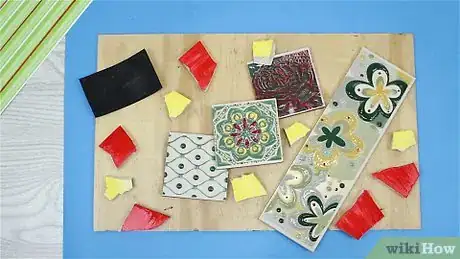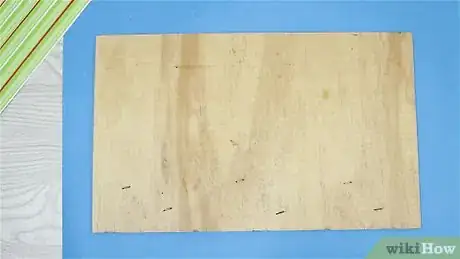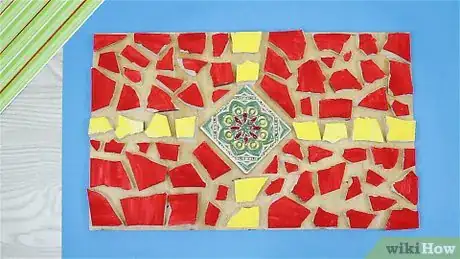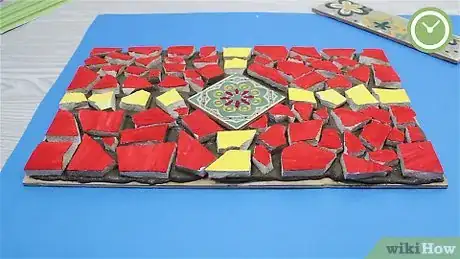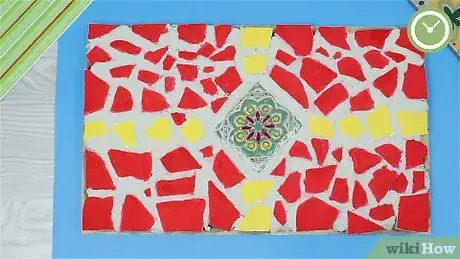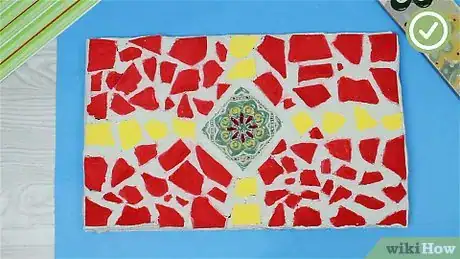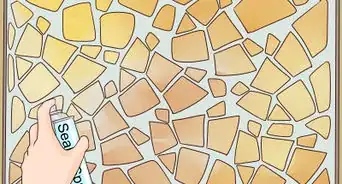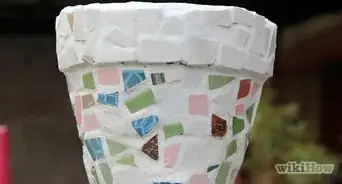This article was co-authored by Kathy Leader. Kathy Leader is an Artist and the Owner of The Art Process. With more than 36 years of art education experience, she specializes in providing mixed media art workshops for individuals and groups. In addition, she works with businesses and organizations to build morale, encourage creative problem solving, and find de-stressing tools. Kathy holds a BFA in Art Education from The University of Cape Town.
This article has been viewed 30,660 times.
Mosaics are works of art created by using glass or ceramic tiles and grout to make a picture. They date as far back as 1500 BC and are all over the world. Mosaics adorn the ceilings in cathedrals with elaborate details or they can be found in a simple pattern on the coffee table in your home. While mosaic art looks very complicated, it is actually a very easy way to express your artistic creativity. With practice, you can create a custom mosaic all your own.
Steps
Preparing to Create Your Mosaic Art
-
1Select the material you wish to use. Pieces of material used in mosaic art are called tesserae. They can be glass, stones, porcelain, seashells, or whatever else you can find.[1] You will also want to gather together any objects you might want to include. These could include buttons, bones, metals, etc.[2] [3] [4]
- If you can, find them already precut into distinct shapes and sizes. This will keep you from having to break them with a hammer/saw later.
- Choose a wide variety of colors and shades. Even if your work will be mostly monochromatic, you will want varying values and ones.
- Choose tesserae that goes with the art you wish to create. For example, if you are doing a beach scene, it might be best to use a wide variety of shells. If you are looking to recreate the Brooklyn Bridge, you might want to look into metals.
-
2Pick the foundation to adhere the mosaic tiles on. Tables, planters, birdbaths, or walking stones are just a few ideas to use.[5] You can make almost anything work as a base. Wood, terracotta and/or glass are usually what people use as a base. Make sure the base is strong enough to hold the weight of the tesserae and grout.[6] [7]
- Choose bases which have large, open spaces and that are solid.[8] If there are numerous crevices on your base, it may be hard to create mosaic pieces which will fit.
Advertisement -
3Clean your base appropriately. Every base needs to be cleaned off before you adhere the mosaic tiles down, otherwise they will not stick properly. For most bases, you can simply use water and a basic home cleaner. Scrub the dirt and grim off, and then dry the surface off. Go back over the surface a few more times in case you missed something.[9] [10]
- For metal bases, use sandpaper and a wire brush in order to remove rust. The now "roughed up" surface has an added benefit, it will make the tiles stick to the surface better.
- Score plastic and/or rubber surfaces with a utility knife in order to help the tiles stick better.
- Sand wood surfaces down, then apply a waterproof sealer. If you don't do this, moisture could soak in, thereby cracking your mosaic art.
-
4Find a pattern you wish to make into a mosaic. Find patterns for free online or use your imagination and come up with your own design. For a first time project, you may wish to work with a simple pattern. This could mean a house, a fish, a landscape, or anything else with simply defined shapes. After you work on a simple pattern, you can graduate up to more complicated projects.[11] [12]
-
5Transfer the design to your base. Print out the pattern to the dimensions needed. Begin transferring the design, first using a pencil. This will allow you to adjust for mistakes and inconsistencies. Once you have a rough outline with a pencil, go back and trace over the lines with a pen or marker, depending on the type of base. If you are using a basic design, this might be the time to add in details that are not present in the original design.[13] [14]
- If the pattern is extra large, do it in sections. Remember this is a rough outline, which can be changed when you start to lay down specific tiles.
- If you are using an original design, simply draw it directly onto the base. However, don't over plan. Spontaneity is key to creating artistically stunning art.
Creating Your Mosaic Art
-
1Cut your mosaic objects into pieces. In order to get the mosaic "look" you will need to create different shapes and sizes of pieces. Remember, before you begin to break your mosaic objects into pieces, you need to be wearing safety goggles, gloves, and an apron. Pick a safe place to cut your objects, like an empty garage, or outdoors in your backyard. If you are just looking to make randomly sized pieces, a basic hammer works best. However, there are some more specialized ways.[15] [16] [17]
- Tile nippers and cutters are used to create straight lines and curves.[18] They can be found at most hardware, and arts and crafts stores. These are used to cut through porcelain, ceramic, china, etc. Cut through the object you are using about halfway through. They, using your hands, break the piece off.
- Glass nippers and cutters work the same way, except that they are specially designed for cutting glass.
- When you are creating the pieces, look at your design. Try to envision what shapes you will need in order to fill the pattern. If you miss a piece, or mis-cut one, you can always come back later to cut a new one.
-
2Lay your mosaic tesserae overtop of the pattern. Take each of your new pieces you have created and place them where you will eventually stick them. This is a great opportunity to mix around shapes, sizes and colors. Once you get a basic layout of your pieces, find where the missing pieces are, or where you need a better shaped piece. Then go back and create a new one which better fits the design.[19] [20]
- Once you have your objects laid out the way you want them, you then have two options: leave them there, or take them off.
- If you choose to leave them there, you will apply mortar directly to the pieces. This garners a more accurate design, but takes a lot longer and can be more tricky.
- If you choose to take them off, place the pieces to the side in the same pattern they were placed on the base. You will be applying mortar onto the base. This garners a less accurate pattern, but is much easier to accomplish.
-
3Mix together a mortar mixture. You can find mortar mixtures at most local hardware stores. You will want to mix together 2-3 cups of mortar mixture with an acrylic admix. Stir the mixture together until the consistency is like thick cottage cheese. Only mix together small amounts as you work, as the mortar mixture cannot be preserved.[21]
-
4Apply your mortar mixture. Depending on whether you have left the pattern on, or taken it off, will change whether you apply the mortar to the pieces or the base, respectively. Use a small knife or scalpel. When you are applying the mortar, wear gloves so that mortar does not stick to your hands. Mortar is basically a type of cement which can be difficult to get off.[22] [23]
- If you are applying the mixture to the base, only do one section at a time. Spread on a few inches, length wise, onto the base. You only need about a 1/4 inch width of mortar.
- If you are applying it to the pieces themselves, take your knife and apply the mixture to the back of the piece. Try to keep most of the mortar adhered to the back by gently pressing the mixture with your hands. Scrape off excess mortar from around the outside edge of the piece before you apply it.
-
5Affix your pieces to the base. While still wet, gently affix the mosaic tiles by pushing them down onto the base. Apply tiles starting in one corner of the design and work across in rows. Make sure you leave enough space between pieces for grout, about 1/8 inch gaps. Every time you lay down a new piece, scrape off any excess mortar which is readily apparent. If you don't, the mortar will solidify and be hard to get off.[24] [25]
-
6Let the mortar set. Time varies depending on usage, so follow manufacturer recommendations. For pieces in your home, the timing is roughly 24 hours. Outdoor mosaics will need to set for 72 hours. Clean the mosaic tiles once more to clear away any extra mortar that may have risen to the top.[26]
Finishing Your Mosaic Art
-
1Prepare the grout mixture.[27] Combine together 2-3 cups of grout mixture with a bit of acrylic admix. Stir the combination until the consistency is that of thick cottage cheese. Grout comes in many colors and there are colors you can add to the grout to change the coloring. Choose a color that accents your mosaic.[28] [29]
-
2Apply the grout using a spatula.[30] Fill in the creases between the tiles. The grout should cover the mosaic enough to fill the gaps. Work in small areas at a time and wipe off any excess grout as you go along. Each time you grout around a new piece, give the tesserae a gentle push to make sure the tile sticks to the grout.[31]
- Make sure you are wearing gloves as you apply, otherwise the grout will stick and solidify on your hands.
-
3Let the grout set between 24-48 hours. Wipe the mosaic with a clean sponge and warm water. Rinse out the sponge regularly as you wipe away grout from the surface of the tiles. After you are done cleaning, let the water sit in the bucket for a while. The grout will sink to the bottom. You can then pour out the water, and dump the grout into a trashcan.[32] [33]
-
4Seal the mosaic with varnish. This will coat the tiles and safeguard against damage, especially for outdoor mosaics subjected to fluctuating temperatures and adverse weather conditions. It also will give a high gloss shine that will make the colors stand out. Tile and stone-floor sealers can be purchased at most local hardware stores.[34] [35]
- You will want to apply two coats. Use a paintbrush to apply each coat. In between coats, wait about 10-15 minutes for the varnish to dry.
- After the sealer has dried, buff the mosaic with a soft towel. This will give your mosaic a nice clean finish.
- Reapply every few years for added protection.
-
5Create an edging for your mosaic. This is strictly optional, but can add a level of dimension to your work, especially if it is a tile or table. You can affix pieces of tesserae to the edges using the same mortar and grout steps. Another great option is the paint the edges using an acrylic paint. You can also pack grout onto the edges, using a spatula, for a more textured look.[36]
-
6Finished.
Warnings
- Wear safety glasses and use gloves while working on this project. The tile pieces can have sharp edges and the mortar/grout can get stuck to your hands.⧼thumbs_response⧽
- Make sure to look at the manufacturer's instructions on the grout and mortar packaging. The steps above are general rules, but the mixture you buy might have specific instructions to follow.⧼thumbs_response⧽
Things You'll Need
- Tile pieces
- Foundation for mosaic
- Design template
- Glass or tile cutting tools
- Mortar
- Small knife or scalpel
- Grout
- Sponge
- Bucket of warm water
- Varnish
References
- ↑ Kathy Leader. Artist. Expert Interview. 13 February 2022.
- ↑ http://www.inlandcraft.com/howto/mosaic/mosaic1.htm
- ↑ http://www.finegardening.com/making-mosaic-garden-art
- ↑ Kathy Leader. Artist. Expert Interview. 13 February 2022.
- ↑ Kathy Leader. Artist. Expert Interview. 13 February 2022.
- ↑ http://www.totalmosaic.com/mosaic-basics-a/132.htm
- ↑ http://www.inlandcraft.com/howto/mosaic/mosaic1.htm
- ↑ Kathy Leader. Artist. Expert Interview. 13 February 2022.
- ↑ http://www.finegardening.com/making-mosaic-garden-art
- ↑ http://www.inlandcraft.com/howto/mosaic/mosaic1.htm
- ↑ http://www.mosaicartsupply.com/illustrated-mosaic-instructions/
- ↑ http://www.inlandcraft.com/howto/mosaic/mosaic1.htm
- ↑ http://www.mosaicartsupply.com/illustrated-mosaic-instructions/
- ↑ http://www.inlandcraft.com/howto/mosaic/mosaic1.htm
- ↑ http://www.inlandcraft.com/howto/mosaic/mosaic1.htm
- ↑ http://www.totalmosaic.com/mosaic-basics-a/132.htm
- ↑ http://www.hgtv.com/design/make-and-celebrate/handmade/how-to-make-mosaic-stained-glass-art
- ↑ Kathy Leader. Artist. Expert Interview. 13 February 2022.
- ↑ http://www.mosaicartsupply.com/illustrated-mosaic-instructions/
- ↑ http://www.inlandcraft.com/howto/mosaic/mosaic1.htm
- ↑ http://www.finegardening.com/making-mosaic-garden-art
- ↑ http://www.inlandcraft.com/howto/mosaic/mosaic1.htm
- ↑ http://www.totalmosaic.com/mosaic-basics-a/132.htm
- ↑ http://www.mosaicartsupply.com/illustrated-mosaic-instructions/
- ↑ http://www.finegardening.com/making-mosaic-garden-art
- ↑ http://www.totalmosaic.com/mosaic-basics-a/132.htm
- ↑ Kathy Leader. Artist. Expert Interview. 13 February 2022.
- ↑ http://www.finegardening.com/making-mosaic-garden-art
- ↑ http://www.inlandcraft.com/howto/mosaic/mosaic1.htm
- ↑ Kathy Leader. Artist. Expert Interview. 13 February 2022.
- ↑ http://www.inlandcraft.com/howto/mosaic/mosaic1.htm
- ↑ http://www.finegardening.com/making-mosaic-garden-art
- ↑ http://www.mosaicartsupply.com/illustrated-mosaic-instructions/
- ↑ http://www.finegardening.com/making-mosaic-garden-art
- ↑ http://www.inlandcraft.com/howto/mosaic/mosaic1.htm
- ↑ http://www.totalmosaic.com/mosaic-basics-a/132.htm
